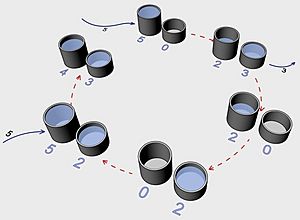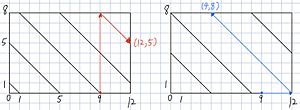Water pouring puzzle facts for kids
Water pouring puzzles are fun brain teasers. They are also known as water jug problems or measuring puzzles. In these puzzles, you have a few empty or partly filled containers, called jugs. Each jug can hold a certain amount of water, like 8 liters or 5 liters.
Your goal is to measure a specific amount of water. You do this by pouring water from one jug to another. You can only pour until one jug is empty or the other is full. The challenge is to find the fewest steps to reach your goal.
Contents
How to Play: The Rules
These puzzles have simple rules. Imagine your jugs are oddly shaped and have no measuring lines on them. This means you can only know the amount of water when a jug is completely full or completely empty.
You cannot spill any water. When you pour, you stop when either:
- The jug you are pouring from becomes empty.
- The jug you are pouring into becomes full.
These rules make the puzzles tricky and fun to solve!
A Classic Example Puzzle
One very famous water pouring puzzle uses three jugs. They can hold 8 liters, 5 liters, and 3 liters.
- At the start, the 8-liter jug is full. The 5-liter and 3-liter jugs are empty. So, the amounts are [8, 0, 0].
- Your goal is to have exactly 4 liters in two of the jugs. For example, [4, 4, 0].
This puzzle can be solved in seven steps:
- [8,0,0] → [3,5,0] (Pour from 8L to 5L)
- [3,2,3] (Pour from 5L to 3L)
- [6,2,0] (Empty 3L into 8L, or pour 3L into 8L if 8L was empty)
- [6,0,2] (Empty 5L)
- [1,5,2] (Pour from 8L to 5L)
- [1,4,3] (Pour from 5L to 3L)
- [4,4,0] (Empty 3L into 8L)
This puzzle has been around for a very long time, even since medieval times! It was written about in a math book in the 1600s.
Puzzles with Taps and Sinks
Sometimes, the rules for these puzzles are a bit different. You might have a water tap that gives you endless water. You might also have a sink where you can pour out all the water from a jug.
- Filling a jug from the tap counts as one step.
- Pouring a jug's entire contents into the sink also counts as one step.
This type of puzzle was even shown in the 1995 movie Die Hard with a Vengeance. In the movie, the characters had to solve a water puzzle to stop a bomb!
Even with a tap and a sink, these puzzles are similar to the original ones. Having a tap and sink is like having a really big extra jug that can hold all the water.
Measuring Different Amounts
What if one jug already has some water in it? For example, imagine an 8-liter jug is empty, but a 12-liter jug has 9 liters of water. With a tap and sink, you can measure many different amounts. You could measure 9 liters, 5 liters, or even 1 liter. You could also measure 12 liters, 8 liters, 4 liters, or 0 liters.
Here are some ways to get specific amounts:
- To get 5 liters: Start with [9,0]. Pour 9 liters into the 8-liter jug, so you have [9,8]. Then, pour from the 8-liter jug into the 12-liter jug until the 12-liter jug is full. This leaves 5 liters in the 8-liter jug: [12,5].
- To get 4 liters: Start with [9,0]. Empty the 9-liter jug into the sink, so you have [12,0]. Then, fill the 8-liter jug from the tap, and pour it into the 12-liter jug. This leaves 4 liters in the 12-liter jug: [4,8].
Solving with Three Jugs
When you have three jugs, you can use a special type of diagram to help solve the puzzle. This diagram helps you see how the water levels change after each pour. It's like a map of all the possible steps you can take.
The diagram on the right shows two ways to solve the 8, 5, and 3-liter puzzle. The yellow area shows all the different amounts of water you can have in the jugs. Each step of pouring water is like moving along a line on this map. When you land on the dotted black triangle, you have measured 4 liters.
|





